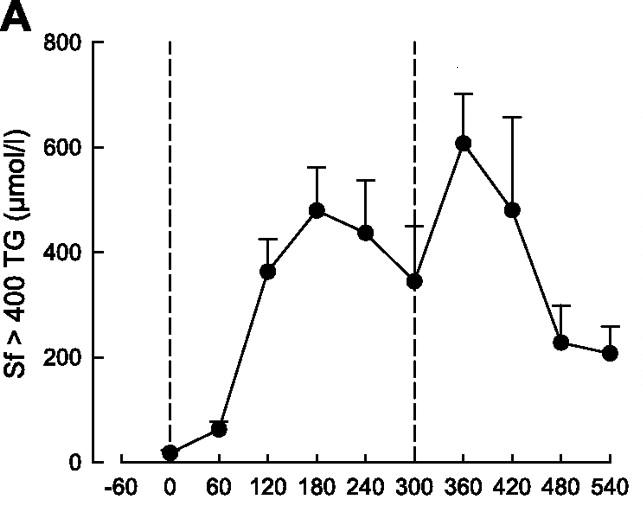Continuing the comments started in Grazing is for cattle, here's an interesting study from the Oxford Center for Diabetes, Endocrinology and Metabolism.
Volunteers were fed a test meal breakfast of Rice Krispies, a banana, and a chocolate milkshake (76.4 grams carbohydrates, 51.9 grams fat, 12.2 grams protein). Lunch was served 5 hours later and consisted of a cheese sandwich and a second chocolate milkshake 43.4 grams carbohydrates, 49.6 grams fat, 24.0 grams protein). Frequent blood samples were then assessed over the day. (Don't try this at home: These are obviously very dangerous foods!)
Here's the pattern of triglycerides that was observed (1st dotted vertical line = breakfast, 2nd dotted vertical line = lunch):

Note that triglycerides only begin to decline 3-4 hours after breakfast, only to peak higher after lunch.
Here's the pattern observed for chylomicrons, the "granddaddy" of lipoproteins that derives from intestinal absorption of fatty acids:

Both graphs from Heath RB et al Am J Phyiol Endocrinol Metab 2006.
With chylomicrons, note a similar pattern to triglycerides: Chylomicrons begin to decline at 3-4 hours, only to peak higher after lunch.
This is the first study to examine the effect of sequential meals on such postprandial (after-eating) patterns. But it makes the graphic point that, if insufficient time is permitted between meals, both triglycerides and chylomicrons will "stack" themselves higher and higher. (Chylomicrons are subjected to processing by the enzyme, lipoprotein lipase, to form highly atherogenic, or plaque-causing, chylomicron remnants.)
While not examined in this study, my bet is that "grazing," i.e., eating small meals or snacks frequently, is an extreme instance of triglyceride, chylomicron, and chylomicron remnant stacking . That can only lead to one thing: accelerated heart and vascular plaque.